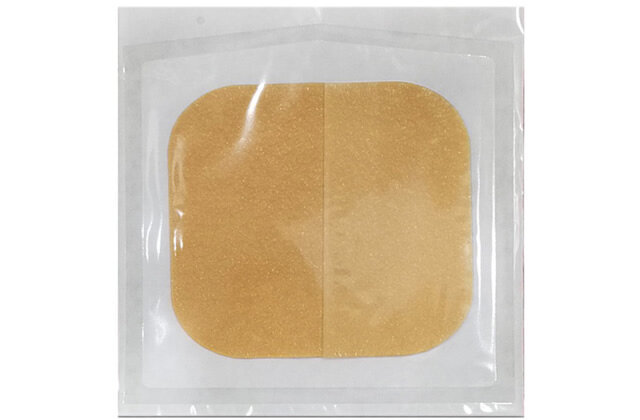14
2021
-
01
Function of hydrocolloid dressing Method of use of hydrocolloid dressing
author:
1、 What is hydrocolloid dressing
Hydrocolloid dressings are made of elastic polymeric hydrogels, synthetic rubber and adhesive materials. The most common gel in the dressing is hydroxymethyl cellulose. This gel can be firmly attached to the skin at the edge of the wound and can swell 12 times after absorbing the exudate.
2、 Characteristics of hydrocolloid dressing
1. It has the ability to absorb wound exudation. After absorbing the exudate, the hydrophilic particles in the dressing can form a semi-solid substance similar to gel, which attaches to the wound base, providing and maintaining a wet environment conducive to wound healing.
2. It is sticky and can form an occlusive wound. The closed healing environment can promote the proliferation of microvessels and the formation of granulation tissue, thus accelerating the wound healing.
3. It can play the role of debridement. On the one hand, hydrocolloids contain endogenous enzymes that can promote the dissolution of fibrin; On the other hand, the closed environment provided by hydrocolloid dressing is conducive to the removal of necrotic tissue by macrophages.
3、 Applicable scope of hydrocolloid dressing
1. Transparent paste is mainly used for wounds with less exudate, such as superficial burns, partial cortical burns, wounds in the skin donor area, post-operative wounds and skin abrasions. The sacral special dressing in the transparent patch is applicable to the sacrococcygeal wound.
2. The ulcer patch is mainly applicable to wounds with low to moderate exudates, such as leg ulcers and pressure sores; It is also used for superficial burns, partial cortical burns, wounds in the skin donor area, wounds after surgery and skin abrasions.
3. Decompression patch is mainly used for the prevention and treatment of pressure sore.
4. Butterfly patch is mainly used for the prevention and treatment of pressure sores that are difficult to fix.

4、 Effect of hydrocolloid dressing
The hydrocolloid dressing is mainly used for the treatment of chronic wounds such as pressure sores and venous ulcer wounds. Pressure sore is a complication of long-term bedridden patients and a major problem in clinical nursing. Hydrocolloid dressings are often used to treat stage II-III pressure sores. Many clinical studies have shown that hydrocolloid dressings are superior to traditional gauze dressings in terms of wound healing, the number of dressings changed and the degree of pain caused to patients when changing dressings.
1. Wound care
The hydrocolloid dressing can also be used for the care of acute wounds. For the wound of donorsite, the healing time after treatment with hydrocolloid dressing is about 40% shorter than that of traditional treatment methods [3]. Hydrocolloid dressing has similar beneficial effects in the treatment of surface wounds and surgical wounds. In addition, hydrocolloid dressings have the effect of alleviating the pain of patients when treating burns.
2. For children
Hydrocolloid is also an ideal dressing for children. After the application of hydrocolloid dressing, children who are naturally active can still play without restraint, because the sealing characteristics of the dressing can protect the wound from being infected by bacteria that may come into contact with it. In addition, hydrocolloid dressing will not cause pain to children when it is removed.
Hydrocolloid dressing is a new type of wound dressing developed under the guidance of the principle of wet healing. The hydrocolloid dressing can be used for the treatment of various wounds, especially for chronic refractory wounds. The absorbability and viscosity of hydrocolloid make it meet the basic requirements of ideal dressing, that is, to protect the wound, to provide a suitable environment for promoting wound healing, and to remove easily without damaging the new tissue. Of course, hydrocolloid dressings still have room for further development, such as improving absorption and enhancing antibacterial ability.
5、 Application method of hydrocolloid dressing
1. First, clean the skin of the patient under pressure with warm water; Then scrub the skin of the pressure part with physiological saline. If there is a wound, wash the wound with physiological saline and gently dry the skin around the wound; Tear off the protective paper, cover the adhesive side with dressing on the wound, and then tear off the non-contact protective film.
2. The dressing should be changed according to the amount of wound exudation and the quality of the dressing itself. Generally, it should be changed once every 1-3 days; When the ulcer patch, transparent patch and transparent patch are absorbed and saturated, the appearance of the dressing will become milky white and transparent, and the dressing will be replaced at this time; When the foam thickness of the pressure relief sticker is reduced by half, it should be replaced; If there is leakage, please replace the dressing in time.
3. When using the pressure relief patch, remove the foam ring with the orange mark according to the size of the wound, so that the area without foam is slightly larger than the wound by 1.5-2 cm. Tear off the protective paper of the dressing, gently press the dressing from one side to the other, cover the wound, then tear off the protective paper on the microporous adhesive, and gently cover the wound.
Indications: all kinds of low to moderate exudative wounds, venous ulcers of the lower extremities, stage I-II bedsores, small area shallow burns, post-operative wounds, wounds in the skin donor area, various types of superficial wounds and plastic and aesthetic wounds, granulation and epithelialization of chronic wounds.
Related news
Bull turns the world, 2021 let us move forward firmly!
2021-01-14
[Depth] Collagen dressings belong to high-end medical dressings, with broad market development space in the future
2022-07-25
Analysis of the market situation and competitive pattern of China's medical dressing industry The export scale ranks first in the world
2022-03-25
How many kinds of medical instruments do gauze bandages belong to? Can gauze bandages directly contact wounds
2021-02-26

- --Friendly link--

Follow us

Mobile browsing
Copyright © Jiangxi Gemei Medical Supplies Co., Ltd. www.300.cn



